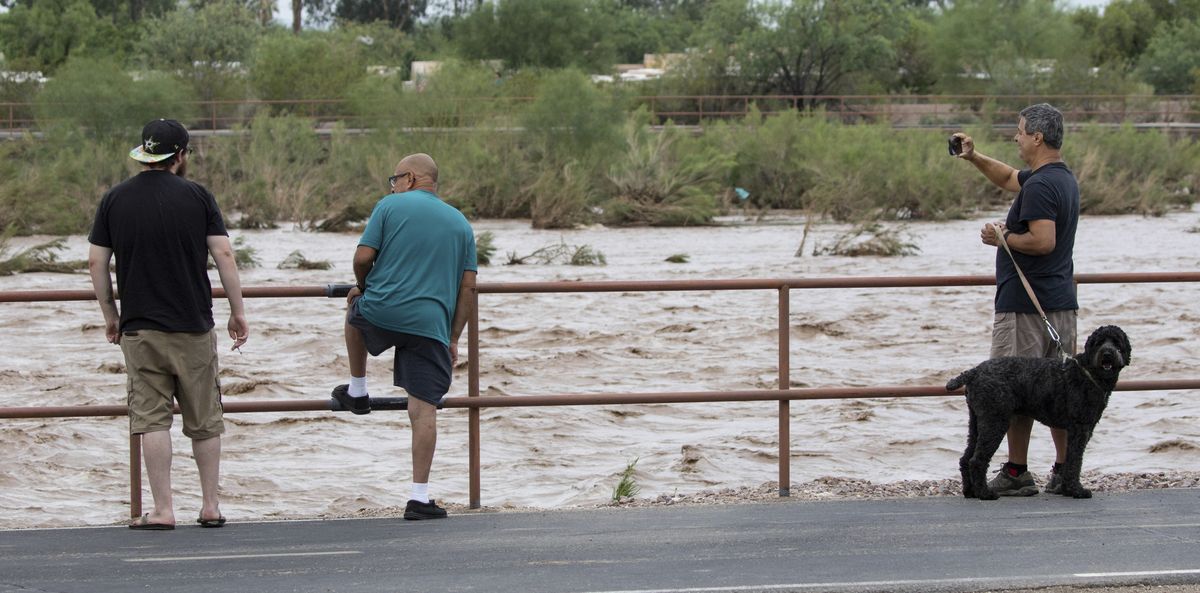Rainy season unleashes with fury, beauty in Southwest

FLAGSTAFF, Ariz. — After two bone-dry years that sank the U.S. Southwest deeper into drought, this summer’s rainy season unleashed with fury.
Monsoon storms have brought spectacular lightning shows, bounties of wildflowers and mushrooms, and record rainfall to the region’s deserts. They’ve also brought destruction, flooding streets and homes, and leading to some swift water rescues and more than a dozen deaths.
It’s a remarkable reversal from 2019 and 2020, when the annual period known simply as “the monsoon” left the region parched. The seasonal weather pattern that runs from mid-June through September brings high hopes for rain, but the moisture isn’t guaranteed.
“That traumatized a lot of us here in the Southwest, really worried if the monsoon was broken,” said Mike Crimmins, a climatologist at the University of Arizona. “And then here 2021 monsoon comes along, and it’s almost like we’re trying to make up for the last two seasons.”
Tucson, in southern Arizona, marked its wettest July on record and was sitting at No. 3 on Thursday for record rainfall during a monsoon. The Phoenix airport is above average for the season but far from hitting the city’s record, the National Weather Service said. Some higher-elevation cities in metropolitan Phoenix fared better.
Payson has logged nearly 13 inches of rain so far — about 6 inches above normal. An area south of Flagstaff had hail that measured 2.5 inches in diameter, according to the weather service.
“That’s usually something you see in the news across the Midwest in tornado season,” said meteorologist Cindy Kobolb in Flagstaff. “Forecasters that have been here for decades can’t even say the last time they’ve seen hailstones that big in the state.”
Some locations like Window Rock, on the Navajo Nation, and Farmington, New Mexico, were just behind normal so far for the season. The Hopi Tribe recently ordered livestock reductions on the reservation in northeastern Arizona that’s in severe to extreme drought.
“The whole Four Corners area has just been annihilated by drought,” said Clay Anderson, a meteorologist in Albuquerque. “They’ve seen some improvement, but they need a lot more.”
Roswell, in southeastern New Mexico, has received nearly double its normal rainfall, while Albuquerque to the northwest was lagging. Rainfall can fluctuate wildly even within cities because of the hit-and-miss nature of the monsoon.
The remnants of Tropical Storm Nora pushed moisture into the region this week, boosting rainfall totals. With each storm, officials warn of potential flooding dangers. At least 10 people have died in Arizona since the monsoon started this year, and at least four in New Mexico in flooding events.
Despite the abundant rainfall, the region is still trending toward hotter, drier weather because of climate change. All of Arizona is in some level of drought and most of New Mexico, according to the U.S. Drought Monitor.
“I’m really trying to enjoy it for what it is right now, because I don’t think we’ll see this every summer,” Crimmins said.
The monsoon is characterized by a shift in wind patterns that pull moisture in from the tropical coast of Mexico. Many cities in Arizona and New Mexico get much of their annual rainfall during the monsoon. In a strong season, the moisture extends into southern Utah, Colorado and California, Crimmins said.
The downpours can replenish shallow aquifers and boost reservoirs temporarily. But the rain isn’t a fix for drought-stricken lakes and rivers, like the Colorado River, anywhere in the U.S. West. Those systems rely primarily on melting snow and have been dwindling for more than two decades because of a megadrought.
The expected La Nina weather pattern this winter means snowpack in the West could be in short supply, forecasters say. That worries fire managers who have been battling increasingly more severe blazes, like those in California.
“The net effect of a robust monsoon is that it helps in the short-term but can set the Southwest up for an active and prolonged fire season for the following year or two,” said Punky Moore, a spokeswoman for the U.S. Forest Service’s Southwest Region.
The same vegetation that can fuel wildfires when it dries up also feeds insects, said Gene Hall, an entomologist at the University of Arizona. More butterflies, more moths and more pesky mosquitoes, he said.
Some insects, such as the cockroach-like Palo Verde beetle, come out only during the monsoon to mate. Flying ants and termites gather by the hundreds or thousands to mate after monsoon rain, Hall said.
“Water is life in the desert, and we’ve had a lot of water,” he said. “Everything seems to be doing pretty well.”
Count mushrooms in.
Christopher May of Scottsdale has found more than 100 varieties of fungi during trips to Arizona’s mountains this summer, including some rare ones. With more rain, they’re easier to find, sometimes cloaking the forest floor like coral reef in the sea, he said.
“We have some of the best mushroom hunting in the country right now, maybe even the best,” he said.
Anissa Doten has a love/hate relationship with the monsoon. She grew up in Tucson, watching the skies light up as thunderstorms rolled in and listening to the rain. It was her favorite kind of weather, magical almost, she said.
Her feelings are more complicated now that she lives in the shadow of a mountain that burned in 2019 in Flagstaff. The home she shares with her five children repeatedly has flooded this year, including during one storm that officials characterized as a “500-year” rain event.
Each time alerts go off on their phones, they rush to check weather gauges and scramble to ensure everyone is safe and someone is home to pump water and rebuild layers of sandbags.
“It’s totally different anxiety-driven action mode,” she said.